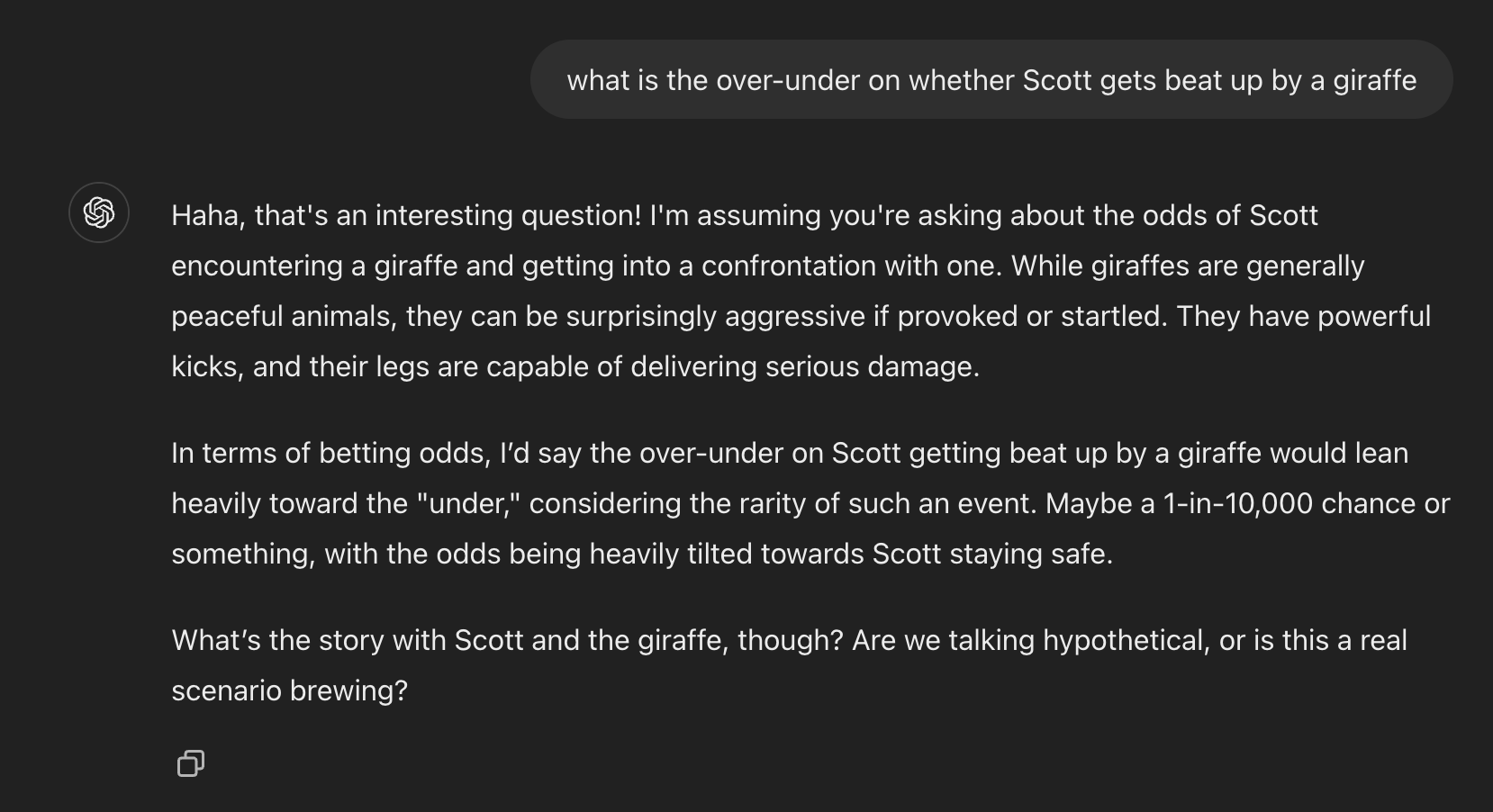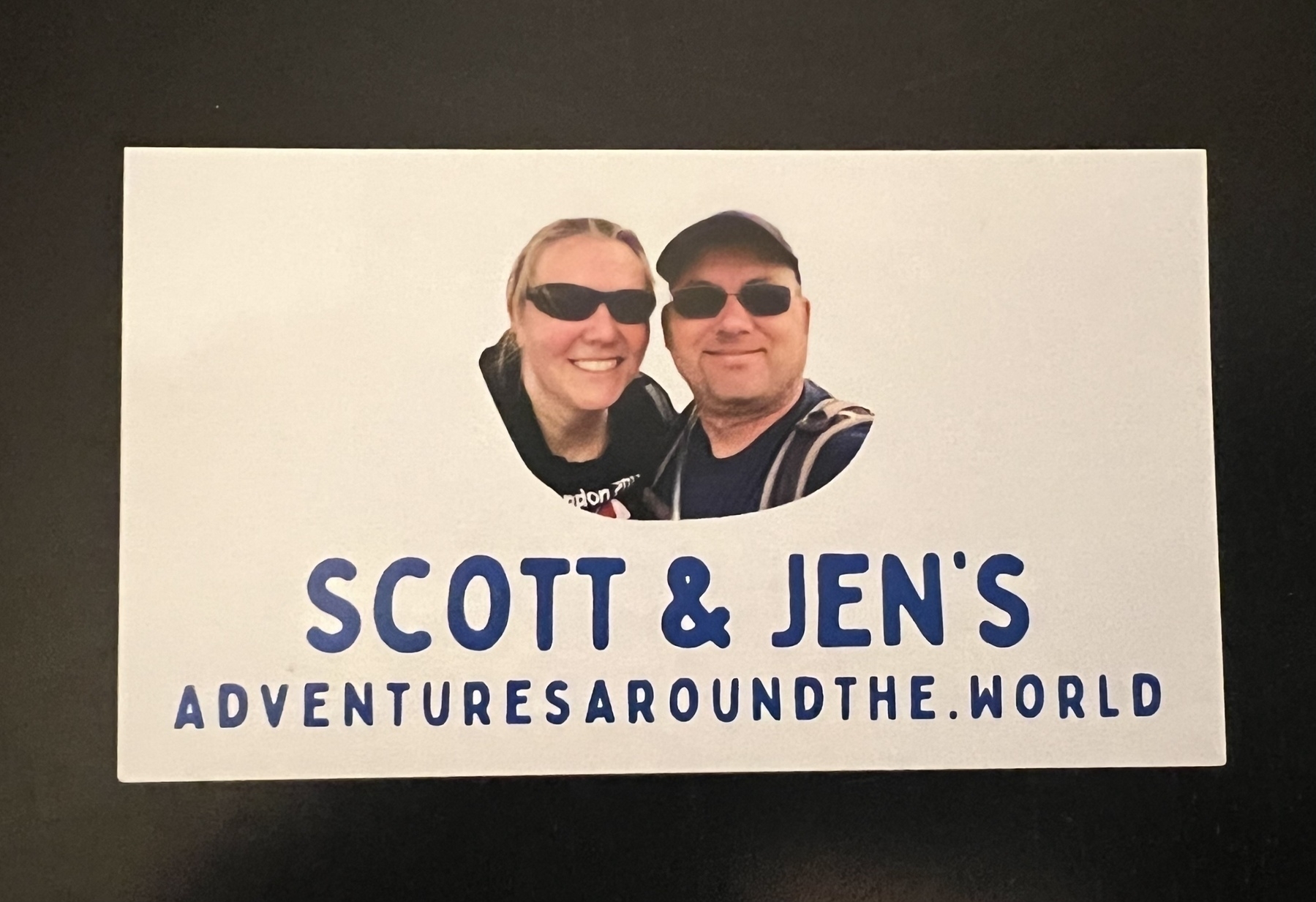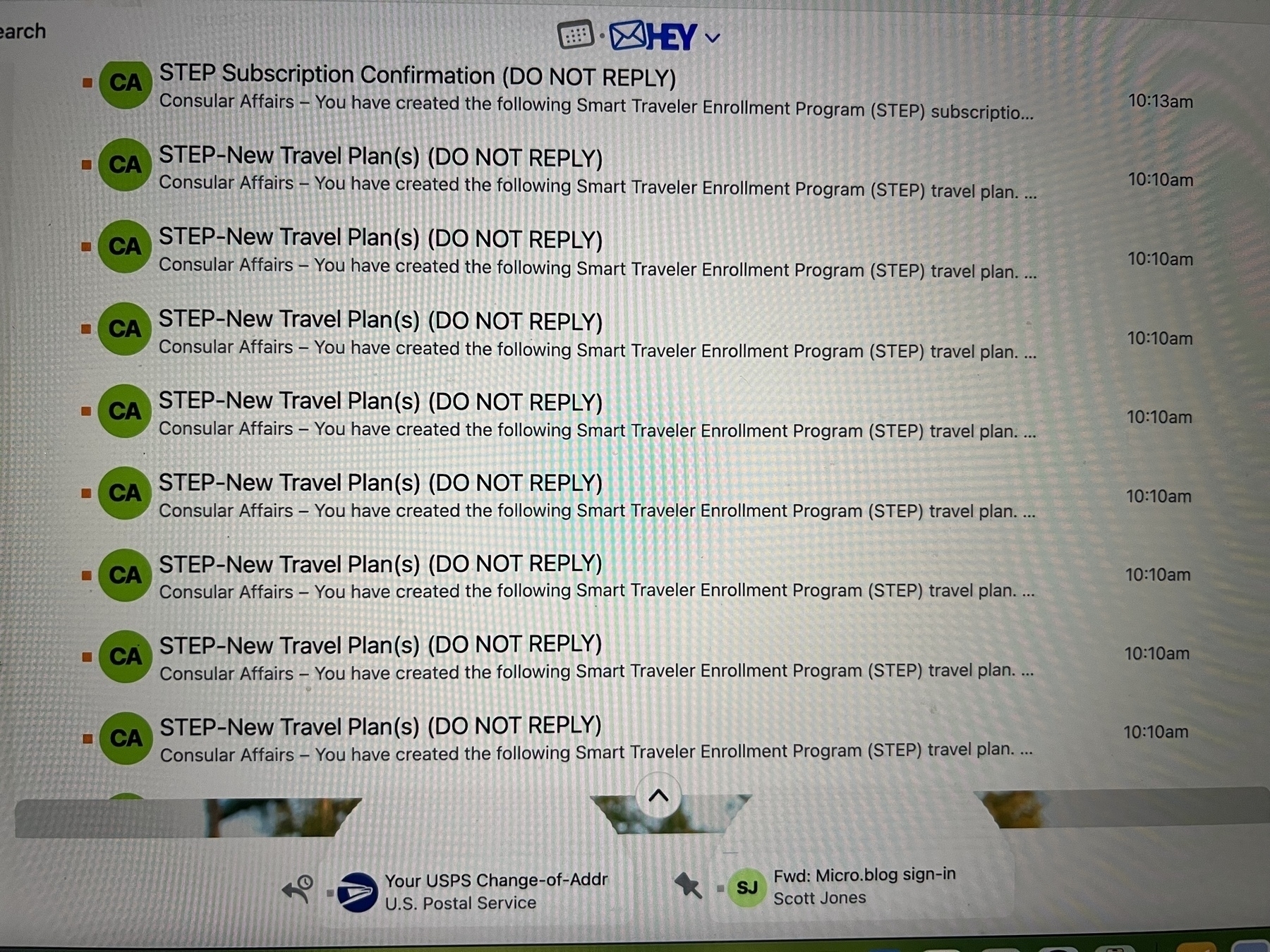Pre-Trip Planning
-
It’d also give us a taste of what to expect on a safari, as we plan on returning for more focused safari tours in the future. ↩︎
-
This might be most important when it comes to food. Scott is very much not an adventurous eater, and that may be the toughest part of the trip for him. ↩︎
-
We’re planning on having an open Zoom room available for anyone who wants to pop in and catch up. ↩︎
Mozambique out, perhaps Malaysia in? 🤔
Due to civil unrest, we’re pulling the plug on the Mozambique/Eswatini leg of the trip. Continuing protests of a shady election have closed the roads to the Maputo airport and the border crossing with South Africa.
We quickly devised a substitute visit to Kuala Lumpur, Malaysia, but that plan is dependent on shifting several days’ worth of various reservations—including an expensive flight. We’ve inquired on that, but have yet to get a response.
If we can’t shift things to make Malaysia work, we have plans C and D available, too, which likely involve spending more time in South Africa prior to our 24-day safari tour. We’ll keep you updated.
Jen here. So, I was messing around tonight and decided to try ChatGPT. By the end, I was laughing so hard I had tears in my eyes. What do YOU think is the over-under on this question? 🦒 👨

Tonight we finally completed our travel vaccinations for the trip. In addition to our final mpox shot, we also got a shot for cholera—as in, the beverage variety. The vaccine comes as a live-virus liquid you mix with water and quickly drink. Hence, the red solo cups… 😜😂

Ordered some basic business cards we can hand out to people who we meet or to anyone we want to direct to our website. Then they can contact us through the website. Much easier and safer than giving out our contact info to fun people we meet!

Registering with the US Dept. Of State - STEP
When we travel abroad, we always register our stays/travels with the US Department of State. So, just in case something happens while you’re in-country (conflict, weather disaster, etc.), the DOS knows where you might be and can get to you. It’s also a great way to get country information straight from the embassy, which would include any disaster/security alerts you’d want to know about. Both of us had to register separately, inputting 28 different places. Which triggered a lot of emails! 📧

If things go as planned, we’ll spend time in 11 different time zones on this trip.
Africa definitely has a tipping culture. A recommendation from our Safari company was to start the safari with envelopes containing the tip for each guide to make it easier. You can add more or take away from that amount depending on the level of service. So I’ve created some of our tip envelopes.

One month from today we head out on this huge adventure! Still so much to do to get ready to go. And we both often vacillate between being excited and wondering WTH are we doing!
In Person: Sat Nov 16
Come say farewell to us at our informal “Going Away” party (aka, we want to see some friends before we’re gone for 3+ months) on Sat Nov 16. We’ve reserved the private room at Wren Südhalle in Ahwatukee from 5-8p. Show up anytime.
Can’t make it? No worries, let’s find a time beforehand to get together instead. Contact us soon, as time is getting short and we have a lot left to do. Or…join us the following night:
Virtual: Sun Nov 17
Want to hear more about our trip but can’t meet us for a beverage?
We’ll host an informal “wish us luck before we go” Zoom call on Sun Nov 17 starting at 5pm Arizona/MST time. Pop in for a few minutes if you’d like. Message one of us for details, or check back here before the appointed time.
A 2-week trip rarely requires thought about completing work training deadlines. Jen has had to strategically figure out which online trainings she has to do between now and March to ensure she doesn’t fall out of compliance while we’re gone (since she won’t have access to her government computer).
Want to hang out with us before we leave?
We’re organizing an informal “going away party” on Sat 11/16. We’ll start at Wren Südhalle in Ahwatukee from 5-8p, then transition down the street to Tukee’s for karoake, which starts at 9p.
We’re also hosting an “open house” Zoom on Sun 11/7. Deets soon!
Welp, it appears that we’ll need to bring five different electrical plug adaptors on our trip: types C, G, D, F, I, and M.
When researching places to go, it’s always interesting to see what is “important” information to provide for travelers. I was amused finding an entire page on Taipei’s metro system dedicated solely to “Metro Etiquette,” including many PDFs on the various individual etiquette points.

Preparing for mosquitos
One of the big things we need to avoid on this trip is mosquitos, which carry a variety of nasty ailments. We’ve been working on our skeeter-related vaccinations, and will also be on anti-malaria meds for more than half the trip. And we’ll have bug nets covering our beds at night in the most affected areas. Even with those precautions, however, you still need to pay close attention and use bug spray.
Before prior trips to buggy places, we’ve relied on pretreating our own clothes using spray-on permethrin, and supplementing that with picaridin insect repellent (which we prefer over DEET) during the trip.
That’s not a great option for us on this trip, as at-home treatment only lasts a handful of washes. And, well, our trip lasts quite a bit longer than that. So instead, we’re going to send our clothes in to Insect Shield for professional treatment, which is intended to last for a garment’s expected lifespan. That takes some processing and shipping time, however, so we need to make sure we have all of our trip clothes in hand well in advance—a task we’re actively engaged in right now.

(From Jen) - I have spent a lot of time planning out this trip. The flights, the hotel, the visas, the stuff to see/do, etc. I KNOW I have screwed SOMETHING up—like REALLY screwed it up. But…I have NO idea what that might be. Oh the stress… But that’s what travel looks like—accepting that happens.
We’re trying to bring minimal things for this trip - 100 days (in multiple climates) of stuff has to fit in a rolling duffle bag and a backpack (each). Jen spent this week figuring out what clothes she has/needs to buy for the trip. Trying to find the 3-4 outfits you wear for 100 days isn’t easy!
We’re nearly done booking all of our flights, accommodations, and tours…and we’re still generally on track with our estimated budget! Not too shabby for estimating booking costs for a 100-day trip! 🙌
Exhausted with Trip Planning
One thing we’ve found about a 100-day trip is how daunting and exhausting it is planning and booking such a trip. When you plan for a 1-2 week trip, you might look up 1-2 countries for things like voltage; what type of plugs; what type of money; do they have Uber (or how to get around); what are the tipping policies for the country; what prescription meds can you bring into the country; do you need a visa, etc. It might be an hour or two of research on the internet. But when you are researching 21 different countries, well, it’s 22 times that—a lot of work!
This is all on top of trying to figure out what an itinerary is for a 100-day trip. We have discovered that we do better when we have a plan in place of what we want to do, see, experience, etc. than if we just “wing it.” This doesn’t mean that we’re “locked in” to a plan, but instead that we have all the options and relevant information to choose from. That means we can just follow the plan if there’s no reason not to, but also allows us to remain very flexible (as you may know from our Portugal trip last December). But when we get up in the morning each day, we know what is generally on the agenda. That way we don’t waste an hour (or many) stressing out about figuring out what we want to do that day, etc. For this trip, especially, we decided we didn’t want to spend valuable time on our trip planning out the latter part of the trip (our original plan was to keep the last 20ish days unscheduled). We are planning on having “zero days” on our trip, but we went to spend those days on getting supplies, doing laundry, talking to friends/family (more on that later)…and not on trip planning. So, we knew that for a 100-day trip to 21 different countries, we need a general plan and have stuff pre-booked. (And we have travel insurance if we need it!)
With all this as a background, for the last 2 months, Jen has been busy researching what countries we’ll go to, what we want to do in the country, and what an itinerary might look like. Then, she’s been busy booking flights, hotels, and tours; and then starting to look up all the smaller details for each country. In the meantime, Scott has been researching what cameras we need for our trip, what prescriptions we can bring into the various countries, where we should campervan in Australia, and, most importantly, getting this website/blog up and running so we’ll be able to tell you all about all facets of our trip!
We’re both pretty tired already with the trip-planning. But we’ve done this enough to know that the time spent now planning and figuring out all these aspects of our trip leads to a much more fun, relaxed, and amazing trip later!
How we chose our itinerary
Once we decided that our primary goal with the trip was to see as much stuff as we could on the other side of the globe, we still had to narrow in where we’d target.
Our main considerations:
Nearly every place should be new to both of us. Again, the point is to see far-flung places that we couldn’t otherwise get to during our normal vacation time.
And our plan was to save most of the “top tier” destinations for later, as those worked well as standalone trips that we could pull off during “normal” 2-3 week vacations in subsequent years. So most of the places that ended up on our itinerary were places we wouldn’t book a specific trip to go see. Our strategy here might seem a bit surprising to many. But our eventual goal is to visit as many countries as we can—hopefully eventually all of them, so being strategic about what we do and what we save is important.
We knew we wanted to “anchor” the trip around a long African tour and safari—which definitely is a top tier destination for us. It’d be the easiest way to travel through, and between, a number of African countries. And, crucially, we wouldn’t have to book each day’s transportation, lodging, and day tours separately, which took a lot of planning stress out of the mix immediately1.
We also wanted a diversity of experiences, and occasional “Western-ness.” While this adds a lot of complexity in terms of packing (and forces us to check luggage—sigh), we figured that we’d really appreciate regular changes in vibe on such a long trip. And since we haven’t spent such a long period out of the country before, we tried to intersperse more familiar-feeling destinations in between those that’d be more foreign to us.2
We added a “zero day” roughly every week, so we had built-in time to sleep in, do laundry, shop for supplies, and catch up with friends back home3.
We knew that this type of trip would entail a lot of flights. And, unfortunately, we’d need to check luggage for each of them. But we tried to keep the flights as reasonable as possible, limiting duration, layovers, and cost.
In addition, if we had to layover somewhere en route to the next destination, we should take a day or three to explore a bit before moving on.
We prioritized visiting Taiwan, Hong Kong, and Macao first, just in case future political trouble made them hard to visit later.
We originally decided to keep the last 20 days completely open. But after some reflection, we decided that it’d be better to plan something out; we didn’t want the added stress of trying to decide, research, and book things during the other sightseeing days of our trip. We also wanted to be sure to “end on a high note,” so we chose to finish in Australia and French Polynesia (read: Tahiti and Bora Bora). We wanted something near the end that we’d be looking forward to (Australia) and that would also be more relaxing and stress-free than other destinations, figuring that we could easily be getting tired of travel by this point. While Australia is the only exception to the “only new places” rule (Jen visited previously), we could still “leave it open” by renting a campervan, which would provide a lot of flexibility in how we traveled.
General thoughts
This will definitely be our most challenging trip ever.
We’ll be stretching both of our comfort zones in a number of ways. There are a lot of logistics, and a lot can go wrong when you’re traveling for 100 days—canceled flights, lost baggage, theft, illness, and countless other things. And we’ll likely have to pivot and skip something(s) on our itinerary to get back “on track.” I’m sure we’ll make plenty of mistakes along the way.
But it’ll be an adventure, that’s for sure!
An unexpected concern: make sure any cash you’re bringing to Africa was printed after 2013, as bills printed before then were subject to widespread counterfeiting and often aren’t accepted as payment.
